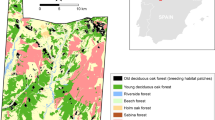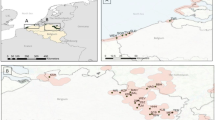Abstract
Studying dispersal is crucial to understand metapopulation and sink-source dynamics and invasion processes. The capability to disperse is especially important for species living in fragmented habitats like wetlands. We investigated the distribution of natal and breeding dispersal distances and philopatry in Spanish populations of two closely related reedbed-nesting birds, the Moustached Warbler Acrocephalus melanopogon and the Eurasian Reed Warbler Acrocephalus scirpaceus. These warblers are morphologically very similar, but differ in migration strategy and, in our study area, in population size. Our aims were to find the best model for dispersal distances and to assess the occurrence of intra- or interspecific differences in dispersal patterns. We used ringing data from the Spanish marking scheme and selected recaptures to avoid including migrating individuals. In both species, most individuals were philopatric but dispersing birds were able to cross large distances (up to more than 100 km), suggesting the capability to compensate for habitat fragmentation. We found the heavy-tailed Cauchy distribution to be the best conceptual description for our data, in all cases but natal dispersal of Moustached Warblers. Among Eurasian Reed Warblers, natal philopatry was lower than breeding philopatry. We found no significant interspecific differences. This does not confirm the hypothesis of higher dispersal ability in long distance migrants (like Eurasian Reed Warblers) than in resident/short distance migrant bird species (like Moustached Warblers). The similarity in dispersal patterns among the two warblers may be explained by their close phylogenetic relatedness, similar constraints imposed on both species by a patchy habitat or similar evolutionary pressures.


Similar content being viewed by others
References
Banco de datos de anillamiento del remite ICONA – Ministerio de Medio Ambiente (2015) Datos de anillamiento y recuperaciones en España. Ministerio de Agricultura, Alimentación y Medio Ambiente, SEO/BirdLife, ICO, EBD-CSIC y GOB. Madrid (in Spanish)
Begon M, Townsend CR, Harper JL (2006) Ecology: from individual to ecosystems, 4th edn. Blackwell Publishing, Oxford
Blomqvist D, Fessl B, Hoi H, Kleindorfer S (2005) High frequency of extra-pair fertilisation in the moustached warbler, a songbird with a variable breeding system. Behaviour 142:1133–1148
Bohonak AJ (1999) Dispersal, gene flow, and population structure. Q Rev Biol 74:21–45
Burnham KP, Anderson DR (2002) Model selection and multi-model inference: a practical information-theoretic approach. Springer Verlag, New York
Cantos FJ, Tellería JL (1994) Stopover site fidelity of four migrant warblers in the Iberian Peninsula. J Avian Biol 25:131–134
Carrascal LM, Palomino D (2008) Las aves comunes reproductoras en España. Población en 2004–2006. SEO/BirdLife, Madrid (in Spanish with English abstract)
Carrascal LM, Weykam S, Palomino D, Lobo JM, Díaz L (2005) Atlas Virtual de las Aves Terrestres de España. http://www.vertebradosibericos.org/atlasaves.html. Accessed 16 Feb 2016
Castany J (2003) El carricerín real (Acrocephalus melanopogon) en el P. N. del Prat de Cabanes-Torreblanca. Doctoral thesis. University of Valencia, Valencia (in Spanish)
Castany J, López G (2006) El carricerín real en España. I Censo Nacional (2005). SEO/BirdLife, Madrid (in Spanish with English abstract)
Ceresa F, Belda EJ, Kvist L, Rguibi-Idrissi H, Monrós JS (2015) Does fragmentation of wetlands affect gene flow in sympatric Acrocephalus warblers with different migration strategies? J Avian Biol 46:577–588
Cooper NW, Murphy MT, Redmond LJ, Dolan AC (2009) Density-dependent age at first reproduction in the eastern kingbird. Oikos 118:413–419
Delignette-Muller ML, Dutang C (2015) fitdistrplus: An R Package for fitting distributions. J Stat Softw 64:1–34. http://www.jstatsoft.org/v64/i04/. Accessed 2 Sep 2015
Frankham R, Ballou JD, Briscoe DA (2010) Introduction to conservation genetics, 2nd edn. Cambridge University Press, Cambridge
Hengeveld R (1994) Small step invasion research. Trends Ecol Evol 9:339–342
Hodges MF Jr, Krementz DG (1996) Neotropical migratory breeding bird communities in riparian forests of different widths along the Altamaha River, Georgia. Wilson Bulletin 108:496–506
Ibrahim KM, Nichols RA, Hewitt GM (1996) Spatial patterns of genetic variation generated by different forms of dispersal during range expansion. Heredity 77:282–291
Kennerley P, Pearson D (2010) Reed and bush warblers. Christopher Helm Publishers Ltd., London
Koenig WD, Van Vuren D, Hooge PN (1996) Detectability, philopatry, and the distribution of dispersal distances in vertebrates. Trends Ecol Evol 11:514–517
Kralj J, Procházka P, Fainová D, Patzenhauerová H, Tutiš V (2010) Intraspecific variation in the wing shape and genetic differentiation of reed warblers Acrocephalus scirpaceus in Croatia. Acta Ornithologica 45:51–58
Lambrechts MM, Blondel J, Caizergues A, Dias PC, Pradol R, Thomas DW (1999) Will estimates of lifetime recruitment of breeding offspring on small-scale study plots help us to quantify processes underlying adaptation? Oikos 86:147–151
Machtans CS, Villard MA, Hannon SJ (1996) Use of riparian buffer strips as movement corridors by forest birds. Conserv Biol 10:1366–1379
Nathan R, Perry G, Cronin JT, Strand AE, Cain ML (2003) Methods for estimating long-distance dispersal. Oikos 103:261–273
Newton I (1992) Experiments on the limitation of bird numbers by territorial behaviour. Biol Rev 67:129–173
Norberg UM (1990) Vertebrate flight, mechanics, physiology, morphology, ecology and evolution. Springer Verlag, Berlin
Paracuellos M, Tellería JL (2004) Factors affecting the distribution of a waterbird community: the role of habitat configuration and bird abundance. Waterbirds 27:446–453
Paradis E, Baillie SR, Sutherland WJ, Gregory RD (1998) Patterns of natal and breeding dispersal in birds. J Anim Ecol 67:518–536
Paradis E, Baillie SR, Sutherland WJ (2002) Modeling large-scale dispersal distances. Ecol Model 151:279–292
Peirò IG (2003) Intraspecific variation in the wing shape of the long-distance migrant Reed Warbler Acrocephalus scirpaceus: effects of age and distance of migration. Ardeola 50:31–37
Plissner JH, Gowaty PA (1996) Patterns of natal dispersal, turnover, and dispersal costs in eastern bluebirds. Anim Behav 51:1307–1322
Procházka P, Stokke BG, Jensen H, Fainová D, Bellinvia E, Fossøy F, Vikan JR, Bryja J, Soler M (2011) Low genetic differentiation among reed warbler Acrocephalus scirpaceus populations across Europe. J Avian Biol 42:103–113
R Core Team (2014) R: A language and environment for statistical computing. R foundation for statistical computing, Vienna
Robinson WD (1999) Long-term changes in the avifauna of Barro Colorado Island, Panama, a tropical forest isolate. Conserv Biol 13:85–97
SEO/BirdLife (2016a) Acrocephalus melanopogon. Anillamientos por década. http://www.anillamientoseo.org/. Accessed 19 Feb 2016 (in Spanish)
SEO/BirdLife (2016b) Acrocephalus scirpaceus. Anillamientos por década. http://www.anillamientoseo.org/. Accessed 19 Feb 2016 (in Spanish)
Shigesada N, Kawasaki K, Takeda Y (1995) Modeling stratified diffusion in biological invasions. Am Nat 146:229–251
Silva JP, Phillips L, Jones W, Eldridge J, O’Hara E (2007) Life and Europe’s wetlands, restoring a vital ecosystem. Office for Official Publications of the European Communities, Luxembourg
Sutherland GD, Harestad AS, Price K, Lertzman KP (2000) Scaling of natal dispersal distances in terrestrial birds and mammals. Conservation ecology 4:16. http://www.consecol.org/vol4/iss1/art16. Accessed 23 Oct 2015
Vadász C, Német Á, Karcza Z, Loránt M, Biró C, Csörgő T (2008) Study on breeding site fidelity of Acrocephalus Warblers in Central Hungary. Acta Zool Acad Sci H 54(Suppl. 1):167–175
Van Houtan KS, Pimm SL, Halley JM, Bierregaard RO Jr, Lovejoy TE (2007) Dispersal of Amazonian birds in continuous and fragmented forest. Ecol Lett 10:219–229
Van Houtan KS, Bass OL Jr, Lockwood J, Pimm SL (2010) Importance of estimating dispersal for endangered bird management. Conservation Letters 3:260–266
Van Vessem J, Hecker N, Tucker GM (1997) Inland wetlands. In: Tucker GM, Evans MI (eds) Habitats for birds in Europe: A conservation strategy for the wider environment. BirdLife Conservation Series 6. BirdLife International, Cambridge, pp 125–158
Waser PM, Creel SR, Lucas JR (1994) Death and disappearance: estimating mortality risk associated with philopatry and dispersal. Behav Ecol 5:135–141
Willis EO (1974) Populations and local extinctions of birds on Barro Colorado Island, Panama. Ecol Monogr 44:153–169
Winkler DW, Wrege PH, Allen PE, Kast TL, Senesac P, Wasson MF, Llambías PE, Ferretti V, Sullivan PJ (2004) Breeding dispersal and philopatry in the tree swallow. Condor 106:768–776
Winkler DW, Wrege PH, Allen PE, Kast TL, Senesac P, Wasson MF, Sullivan PJ (2005) The natal dispersal of tree swallows in a continuous mainland environment. J Anim Ecol 74:1080–1090
Acknowledgments
We are grateful to the many ringers who collected the data during years of fieldwork in Spain. Francesco Ceresa is supported by an “Atraent talent” grant from the University of Valencia.
Author information
Authors and Affiliations
Corresponding author
Rights and permissions
About this article
Cite this article
Ceresa, F., Belda, E.J. & Monrós, J.S. Similar dispersal patterns between two closely related birds with contrasting migration strategies. Popul Ecol 58, 421–427 (2016). https://doi.org/10.1007/s10144-016-0547-0
Received:
Accepted:
Published:
Issue Date:
DOI: https://doi.org/10.1007/s10144-016-0547-0




